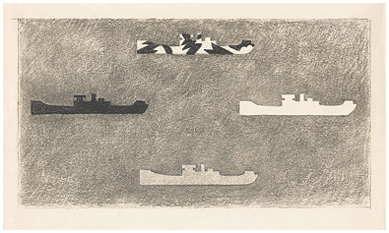Above Abbott Handerson Thayer, Charcoal drawing for ship camouflage experiment, c1915. From Abbott Handerson Thayer Family Collection.
•••
Excerpted from L.W. Leonard and J.L. Seward, The History of Dublin NH. Published by the Town of Dublin, 1920, pp. 684-686—
Throughout the world the word “camouflage” has become familiar during the war. Although this word is of French origin, the thing itself is primarily an American creation, the work neither of warriors nor army experts, but of a distinguished artist, a well-known Dublin resident, Abbott H. Thayer, who has permanently lived here for more than twenty-five years.
In 1896, an essay by Mr. Thayer on “The Law Which Underlies Protective Coloration,” was published in The Auk, and shortly afterwards reprinted in the Year Book of the Smithsonian Institution. In 1909, the Macmillans published Concealing-coloration in the Animal Kingdom, written by Abbott H. Thayer’s son, Gerald H. Thayer, and illustrated by father and son.
Protective coloration, as set forth in this book, was one of the main starting points of camouflage, and to a considerable extent has guided its development. Assurance of these facts were given Mr. Thayer in England and Scotland in the winter of 1915-16, when he went abroad to tender the Allies’ more direct help in this matter.
Professor [Sir William Abbott] Herdman of the University of Liverpool, suggested that the naturalists of Great Britain ought to sign a joint statement to the effect that they believed Mr. Thayer’s unique knowledge of protective coloration could be made of the greatest use to the War Department. It proved, however, that, owing to the efforts of several other British scientists, notably Professor J. Graham Kerr of Cambridge and the University of Glasgow, who had even urged that the government create a special bureau for the adoption of Thayer’s discoveries, “concealing coloration” was already doing war service of various kinds, both on land and sea.
Camouflage has carried the principles of visual deception to hitherto undreamed-of lengths of application, and to manifold and divergent new developments.
But the latest military camouflage was mainly a matter of masking batteries and guns for airplane detection. Standardized materials, wire netting, colored shreds of burlap, etc., manufactured in vast quantities behind the lines were the main dependence for this roofing-over and screening of guns. The latest marine camouflage, again, sought not concealment of ships, but effects of distortion of outline and perspective which would puzzle the U-boat observers looking through the periscope, as to the vessel’s speed, distance, exact form, and especially her course, or direction of movement.
Professor E. B. Poulton, F. R. S., etc., President of the Linnean Society of London, the distinguished English evolutionist, writes as follows:
“During the sixty years which have elapsed since the historic day [of the reading before the Linnean Society of Darwin’s and Wallace’s joint essay on Natural Selection], English-speaking workers—among the foremost the American artist-naturalist, Abbott H. Thayer, and his son Gerald H. Thayer—have studied this principle [protective coloration], continually extending it by the discovery of fresh applications, and analysing it into a whole group of cooperating principles; but inspite of all these naturalists have done, it required the Great War and a misused French word in order to arrest the attention of their fellow-countrymen…
We may, however, forgive the inccurate use of a new word which the war has bought into our language because of the attention which has now been focused upon a most interesting subject—attention which rightly demands a new and widely accessible edition of this work [Thayers’ Concealing Coloration]. Here are clearly explained and illustrated the principles underlying the art of camouflage, practiced by nature from time immemorial but in some of its main lines only made known to man by the discoveries of Abbott H. Thayer.”
